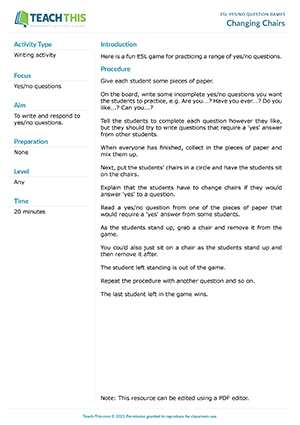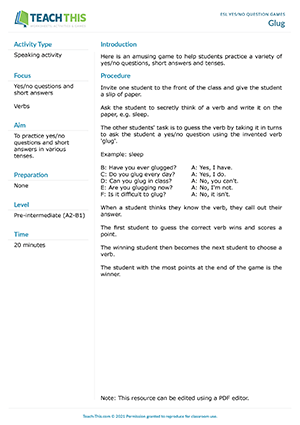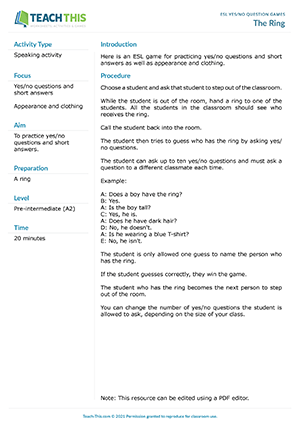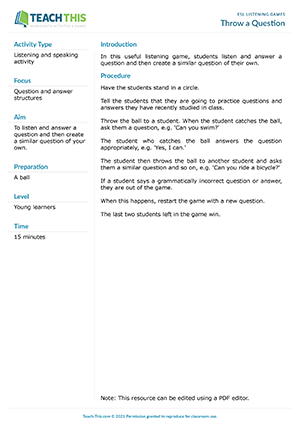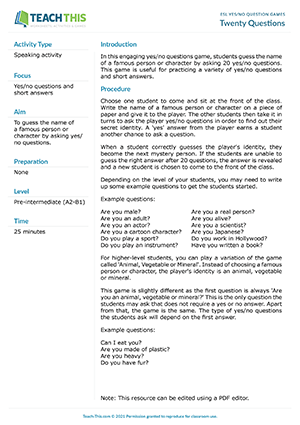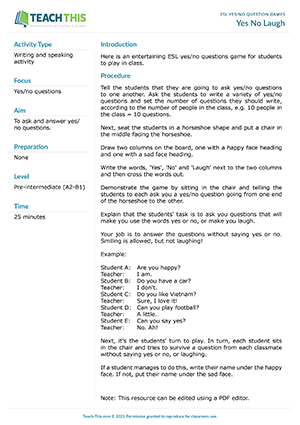ESL Yes/No Question Games
ESL Yes/No Questions Game - Grammar: Writing and Responding to Questions - Any Level - 20 minutes
Here is a fun ESL game for practicing a range of yes/no questions. Give each student some pieces of paper. On the board, write some incomplete yes/no questions you want the students to practice, e.g. Are you...? Have you ever...? Do you like...? Can you...? Tell the students to complete each question however they like, but they should try to write questions that require a 'yes' answer from other students. When everyone has finished, collect in the pieces of paper and mix them up. Next, put the students' chairs in a circle, and have the students sit on the chairs. Explain that the students have to change chairs if they would answer 'yes' to a question. Read out a yes/no question from one of the pieces of paper that would require a 'yes' answer from some students. As the students stand up, grab a chair and remove it from the game. You could also just sit on a chair as the students stand up and then remove it after. The student left standing is out of the game. Repeat the procedure with another question and so on. The last student left in the game wins.
ESL Yes/No Questions Game - Grammar and Speaking: Asking and Answering Questions, Guessing - Pre-intermediate (A2-B1) - 20 minutes
Here is an amusing game to help students practice a variety of yes/no questions, short answers and tenses. Invite one student to the front of the class. The student secretly thinks of a verb and writes it down, e.g. sleep. The other students' task is to guess the verb by taking it in turns to ask the student a yes/no question using the invented verb 'glug'. Example: Have you ever glugged? Yes, I have. Do you glug every day? Yes, I do. Can you glug in class? No, you can't. Are you glugging now? No, I'm not. Is it difficult to glug? No, it isn't. When a student thinks they know the verb, they call out their answer. The first student to guess the correct verb wins and scores a point. The winning student then becomes the next student to choose a verb. The student with the most points at the end of the game is the winner.
ESL Yes/No Questions Game - Vocabulary and Speaking: Asking and Answering Questions, Guessing - Pre-intermediate (A2) - 20 minutes
Here is an ESL game for practicing yes/no questions and short answers as well as appearance and clothing. Choose a student and ask that student to step out of the classroom. While the student is out of the room, hand a ring to one of the students. All the students in the classroom should see who receives the ring. Call the student back into the room. The student then tries to guess who has the ring by asking yes/no questions. The student can ask up to ten yes/no questions and must ask a question to a different classmate each time. Example: A: Does a boy have the ring? B: Yes. A: Is the boy tall? C: Yes, he is. A: Does he have dark hair? D: No, he doesn't. A: Is he wearing a blue T-shirt? E: No, he isn't. The student is only allowed one guess to name the person who has the ring. If the student guesses correctly, they win the game. The student who has the ring becomes the next person to step out of the room. You can change the number of yes/no questions the student is allowed to ask, depending on the size of your class.
ESL Yes/No Question Game - Listening and Speaking: Asking and Answering Questions - Young Learners - 15 minutes
In this useful listening game, students listen and answer a question and then create a similar question of their own. Have the students stand in a circle. Tell the students that they are going to practice questions and answers they have recently studied in class. Throw the ball to a student. When the student catches the ball, ask them a question, e.g. 'Can you swim?' The student who catches the ball answers the question appropriately, e.g. 'Yes, I can.' The student then throws the ball to another student and asks them a similar question and so on, e.g. 'Can you ride a bicycle?' If a student says a grammatically incorrect question or answer, they are out of the game. When this happens, restart the game with a new question. The last two students left in the game win.
ESL Yes/No Questions Game - Grammar and Speaking: Asking and Answering Questions, Guessing - Pre-intermediate (A2-B1) - 25 minutes
In this engaging yes/no questions game, students guess the name of a famous person or character by asking 20 yes/no questions. This game is useful for practicing a variety of yes/no questions and short answers. Choose one student to come and sit at the front of the class. Write the name of a famous person or character on a piece of paper and give it to the player. The other students then take it in turns to ask the player yes/no questions in order to find out their secret identity. A 'yes' answer from the player earns a student another chance to ask a question. When a student correctly guesses the player's identity, they become the next mystery person. If the students are unable to guess the right answer after 20 questions, the answer is revealed, and a new student is chosen to come to the front of the class. For higher-level students, you can play a variation of the game called 'Animal, Vegetable or Mineral'. Instead of choosing a famous person or character, the player's identity is an animal, vegetable or mineral.
ESL Yes/No Questions Game - Grammar and Speaking: Asking and Answering Questions - Any Level - 15 minutes
This engaging ESL game is ideal for practicing yes/no questions and short answers. First, review the yes/no question and short answer structure you want the students to practice. Next, students put their heads down and close their eyes. Walk around the class and touch one student on the shoulder. That student has the virus. Now, ask the students to open their eyes. Students then go around asking each other yes/no questions using the structure you want them to practice, e.g. 'Can you ride a bicycle?' The students must answer positively to each question, e.g. 'Yes, I can.' The student with the virus must answer negatively, e.g. 'No, I can't.' Any student, who asks the student with the virus a question, gets the virus and must also answer negatively. The aim of the game is to avoid catching the virus. After a few minutes, stop the game and see who survived. Any students who didn't get the virus score a point. Then, repeat the game with a different yes/no question structure and so on. The student with the most points at the end of the game wins.
ESL Yes/No Questions Game - Grammar and Speaking: Writing, Asking and Answering Questions - Pre-intermediate (A2-B1) - 25 minutes
Here is an entertaining ESL yes/no questions game for students to play in class. Tell the students that they are going to ask yes/no questions to one another. Ask the students to write a variety of yes/no questions and set the number of questions they should write, according to the number of people in the class. Next, seat the students in a horseshoe shape and put a chair in the middle facing the horseshoe. Draw two columns on the board, one with a happy face heading and one with a sad face heading. Write the words, 'Yes', 'No' and 'Laugh' next to the two columns and then cross the words out. Explain that the students' task is to ask their classmates questions that will make them use the words yes or no, or make you laugh. Each student sits in the chair in turn and tries to survive a question from each classmate without saying yes or no, or laughing. If a student manages to do this, write their name under the happy face. If not, put their name under the sad face.


